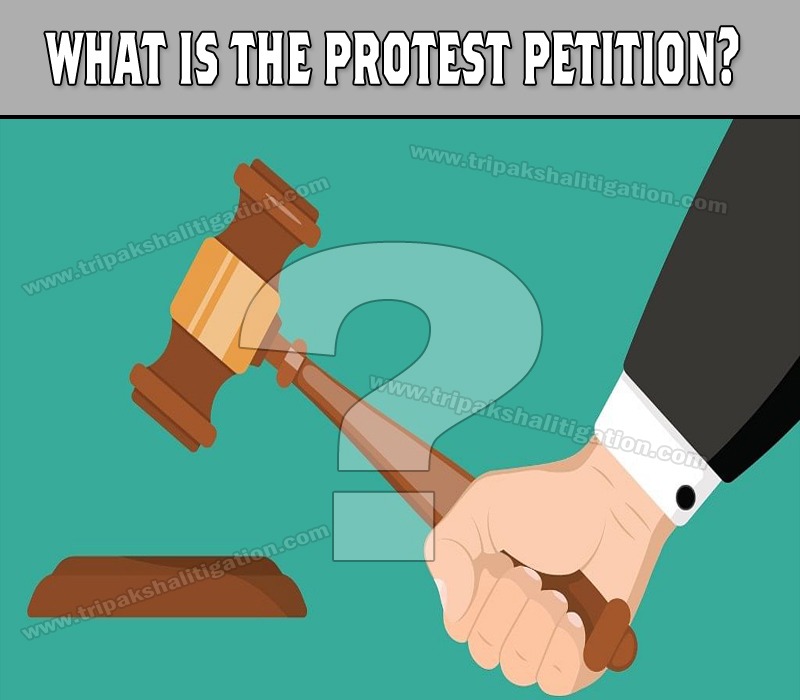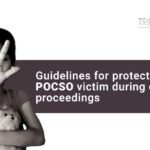Protest petitions were a new concept until a decade ago. But now they are a crucial and enunciate on the rights of the victims giving them a say in the criminal process. It is basically a representation made by the victim/informant to the court during or after completion of investigation by the police. It is an opportunity granted to the victim/complainant to raise objections against the conclusions of the investigation made by the police, commonly it is filed when police presented the final report under section 173 of Code of Criminal Procedure, 1973 wherein the police concludes the allegation are not made out against the accused.
Protest Petition
When an aggrieved person or complainant is not satisfied with the police report which filed before the concerned court, such person may move the petition against the negative police report which is called the Protest Petition.
In simple words, Protest Petition is a representation made by the victim to the court during or after the completion of investigation by the police.
The said petition is treated as Complaint under section 190 of Criminal Procedure Code before the concerned court and same is dealt by the court by looking to all available means and documents on record before the court, therefore let us understand what the section 190 of Cr.P.C.
NARRATION OF PROTEST PETITION THROUGH HISTORY
It was extremely fascinating to trace the development of this concept through time. While the High Courts of Patna and Calcutta had extensively dealt with the legal niceties surrounding Protest Petitions before independence, the first reported judgment from Delhi does not come before 1990 in most databases! Unfortunately, non have yet come across any discussion of how this was a unique method by judges to ensure some measure of ensuring victims-rights, at a time when such concepts were alien to the criminal process across most parts of the world.
Another interesting facet was how the High Courts seem to have considered Protest Petitions as any representations protestingagainst police investigations. The term predominantly used in Calcutta was Naraji, which loosely translates to dissatisfaction. Naturally this extended to petitions filed by both accused persons and complainants/victims, although the latter far outnumber the former. Further, the Protest Petition by an accused seems to have only been filed during the investigation, whereas those by complainants were filed during as well as after conclusion of investigations.
Lastly, the consideration of Protest Petitions and acceptance of Final Reports by the police also raised important issues concerning the nature of this exercise: whether it was an executive or a judicial function. If the task was considered an executive function, this meant there was limited scope for review of such an order in revision proceedings. This is purely of historical interest now, since the present Cr.P.C. makes a clear separation between the executive and judicial functions of the magistracy.
PROCEDURE TO FILE PROTEST PETITION
First, a police report by the officer-in-charge needs to be sent to the Magistrate so that Magistrate can take charge of the case. If the Magistrate decides to reopen the investigation, then under section 200 of the Code of Criminal Procedure, 1973, the Magistrate can examine the victim or witness, where one has the opportunity to narrate their case. To meet the goals of justice victim can go with this remedy where previous investigation had wrongly acquitted the accused. Once the Magistrate establishes that this was not a false complaint and the victim is rightly unsatisfied, he/she can conduct the inquiry by himself/herself, or order an investigation by an officer-in-charge, to whom the complaint is forwarded.
However the essential ingredients of the Complaint must be satisfy in the Protest Petition before Magistrate takes cognizance under section 190(1) (a) of the Code of Criminal Procedure, 1973. There are three options available to the Magistrate, when the final report is submitted by the police and the Protest Petition is filed.
- Firstly, Magistrate may accept the final report and may also reject the Protest Petition.
- Secondly, he may accept the final report but treat the Protest Petition as a Complaint and proceed in accordance with Section 200 and 202 of the Code.
- Lastly, he may accept the Protest Petition and reject the final report and take cognizance under Section 190 (1) (b) of the code.
The correct legal position is that Magistrate is not bound to accept the final report submitted by the police officials. The Magistrate can disagree with that report and take the cognizance even on the basis of police papers, if any submitted along with the police report. Hence, where the Protest Petition is filed, the procedure prescribed for trial of the complaint case has to be followed and Protest Petition has required to be dealt accordingly as per law.
The magistrate may well look at the protest petition beforehand and take cognizance on the Closure Report itself. The magistrate is also empowered to direct a further investigation under Section 156(3) Cr.P.C. after receiving a protest petition. Similarly, it is settled that if the magistrate does decide to take cognizance on the Protest Petition, it must satisfy ingredients of a ‘Complaint’ under Section 2(d) of the Cr.P.C., and then the complainant must be examined on oath before issuing summons.
EVERY PROTEST PETITION IS NOT COMPLAINT
As per the latest verdict on protest petition by Supreme Court all protest petitions are not complaints. In Vishnu Kumar Tiwari v. State of Uttar Pradesh ( Criminal Appeal No. 1015 of 2019), the Supreme Court observed that, “In the facts of this case, having regard to the nature of the allegations contained in the protest petition and the annexures which essentially consisted of affidavits, if the Magistrate was convinced on the basis of the consideration of the final report, the statements under Section 161 of the Code that no prima facie case is made out, certainly the Magistrate could not be compelled to take cognizance by treating the protest petition as a complaint. Undoubtedly, if he treats the protest petition as a complaint, he would have to follow the procedure prescribed under Section 200 and 202 of the Code if the latter Section also commends itself to the Magistrate.
In other words, necessarily, the complainant and his witnesses would have to be examined. No doubt, depending upon the material which is made available to a Magistrate by the complainant in protest petition, it may be capable of being relied on in a particular case having regard to its inherent nature and impact on the conclusions in the final report. That is, if the material is such that it persuades the court to disagree with the conclusions arrived at by the Investigating Officer; cognizance could be taken under Section 190 (1) (b) of the Code for which there is no necessity to examine the witnesses under Section 200 of the Code. But as the Magistrate could not be compelled to treat the protest petition as a complaint, the remedy for the complainant would be to file a fresh complaint and invite the Magistrate to follow the procedure under Section 200 of the Code or Section 200 read with Section 202 of the Code.”
In case of Rajesh v. State of Haryana (Criminal Appeal No. 813 of 2019), the Supreme Court held that, “If police after investigation, finds no role of a particular accused and files charge sheet without implicating him, then if the Trial Court at the stage of summoning finds that a accused should be summoned, even though his name is not in the charge sheet. At that stage Trial Court gives an opportunity to the informant/ complainant to file protest petition.”
CONSTITUTIONAL APPROACH IN PROTEST PETITION:
The article 14 of our Indian Constitution ensures every citizen that equality is there before law. One of the key essentials of ‘Rule of Law’ being this “Equality before law”, as explained by Professor A.V. Dicey while referring to rule of law. Hence, Indian Constitution silently invites rule of law into its constitutional machinery. A member of executive wing of our constitutional system may fail to follow his judgment to needed depth and wrongly takes the cognizance of an offence.The result of which can be considered failure of the machinery set on the principles of our nation’s constitution makers.
Constitution, in its Chapter III read along with Chapter IV, subsequently, empowers every citizen to seek for remedies for breach of their right to get constitutional remedies, for omission of an act which would have lead to proving the FIR was actually justifiable and cognizable in nature but was marked close for some valid reason in the discretion of the police officer in-charge. A protest petition is the silent name for this particular kind of petition against the negative complaint of the police.
COMPLAINANT ENTITLED TO NOTICE BEFORE ACCEPTANCE OF FINAL REPORT (CHARGE SHEET)
Further, in most recent the Supreme Court upheld the judgment of Madras High Court in K.P. RAMASAMY & ORS. VS. R. DHARAMLINGAM & ORS., whereby it was held that a Petitioner, being a victim, is mandatorily entitled to notice before acceptance of final report of the Police and in case such a notice is not served, he has a right to file a protest petition.
The said order was assailed by the Petitioners before the Supreme Court, by way of a Special Leave Petition. Dismissing the same, the bench of Justices Mohan M. Shantanagoudar and R. Subhash Reddy said,
“We do not find any ground to interfere in the impugned order of directing the Magistrate to hear on the protest petition. We clarify that the concerned Magistrate will hear the petitioners also on protest petition and take decision on the point of issuing process or not. The observations made during the course of the impugned order will not stand in the way of the learned Magistrate while deciding protest petition.”
Reliance was placed on Vishnu Kumar Tiwari Vs. State of UP whereby the Apex Court held
“in a case where the magistrate to whom a report is forwarded under sub section (2) (i) of Section 173, decides not to take cognizance of the offence and to drop the proceeding or takes the view that there is o sufficient ground for proceeding against some of the persons mentioned in the first information report, the magistrate must gave notice to the informant and provide him an opportunity to be heard at the time of consideration of the report.
The informant is not prejudicially affected when the magistrate decide to take cognizance and to proceed with the case. But where the Magistrate decides that sufficient ground does not subsist for proceeding or takes the view that there is material for proceeding against some and there are insufficient grounds in respect of others, the informant would certainly be prejudiced as the FIR lodged becomes wholly or partially ineffective.”
Agreeing with this, court said,
“When the Petitioner/victim being a person interested in the complaint is not put on notice of the final report filed in this case, this Court would view the matter placing itself at the stage when the final report was filed before the Magistrate. What follows would be that at such stage, the Petitioner has a right to file a protest petition.”
OPPORTUNITIES AND OBSTACLES OF PROTEST PETITION
OPPORTUNITY
The significance of the protest petition for a victim’s rights is elusive since, the protest petition can be sent directly to the magistrate without police intervention, it expands a victim’s remedies in law and helps in providing justice to the victim.
The protest petition can also be double-edged sword as it can negatively affect the rights of the accused. Example- the magistrate cannot direct further investigation or re-investigation, but can still direct it on the basis of a protest petition, causing the accused to be detained.
OBSTACLES
Apart from its non-existence in statutory literature, it also suffers from lack of certainty due to the limited number of case laws available to discern it from ambiguities.
Enabling magistrates to play the role of prosecutor, rejecting closure reports, sending back for re-investigation, this may affect the fair proceedings. Example- if the same case comes in front of the same magistrate’s court their preconceived notion may affect the proceedings.
CONCLUSION
The Protest Petition is an imperative of judicial innovation. Its existence and development across the country over the last century directly questioned the notions that the role of the victim was negligible in India. Its presence today raised important questions related to the separation between the sphere of investigation and trial. In the present scenario, this predominately area-specific judicial practice has attained national statues. It would be helpful if the federal legislature codified the Protest Petition and made it a part of the Code of Criminal Procedure to address the ambiguities that have arisen during this transformative process.
The criminal procedure code 1973 was amended in 2009 to introduce certain statutory rights for victims of crime. This included the introduction of a Victim’s Compensation Scheme (section 357A Cr.P.C); and conferring a right upon victim to appeal against judgments (proviso of section 372 Cr.P.C). Judiciary has played an important role towards increasing the role of the victim for instance in bail application hearing many judges give opportunity to victims to be heard. The protest petition is one of the creations of judiciary.
Protest petition gives victim an opportunity to get a fair trial in their cases. Innumerable times we have observed that police doesn’t do a thorough investigation in many cases but this we cannot held against them as we all are aware that even police officials are bombarded with heft amount of cases on regular bases. Here, protest petition is a way for victims/complainant to bring their side of investigation and thorough knowledge of the case in front of the trial court (concerned court). This was the conception of judiciary to give victims a chance of having a fair and satisfactorily trial.
The question arises regarding the misuse of protest petition, major cases like 498A, 304 B IPC have similar nature and story to case, if those similar cases falls before the same court who have previously took cognizance on basis of protest petition then there mind will rigid and it will affect the proceedings. But I beg to differ in this regard, as protest petition only gives a chance to victim to represent their side of case thoroughly with relevant evidences and witnesses which has been missed out by police officials during investigation.
It is demonstrable that at various stages of the investigation different views are expressed by the Investigating Officers but the learned Magistrate after considering the protest petition along with any injury report and material available on record will scrutinize the same and take note of the allegations and then exercise the power to reject the final report and take cognizance and also in major cases court even ask the police official to file revised charge sheet.
You may contact me for consultation or advice by visiting Contact Us









wonderful article, please enlighten by giving case laws especially by Hon’ble Delhi High Court and the Apex Court where the police has let off many of the accused persons as they belonged to the police or their accomplices. thx.
Good article. अगर हिन्दी में पढ़ने का ऑप्शन होता तो और बेहतर समझ पाती। मेरे केस में प्रोटेस्ट पीटिशन स्वीकार हुई व पुनः जाँच के आदेश है । आदेश पढ़कर नहीं सुनाया गया इसलिए बात समझने के लिए इन्टरनेट पर पूरी बात समझने की कोशिश कर रही हूँ।
There is no option in neither crpc nor ipc to file protest petition. It’s not law abiding. If police file a refer charge before the court I think further investigation is solution
Protest petition can be filed, please call on 7428871505 to speak with our expert.